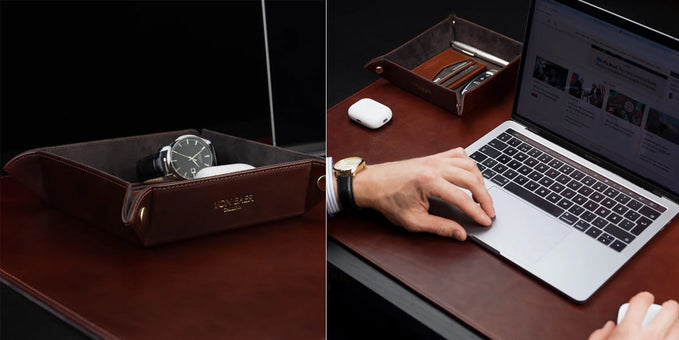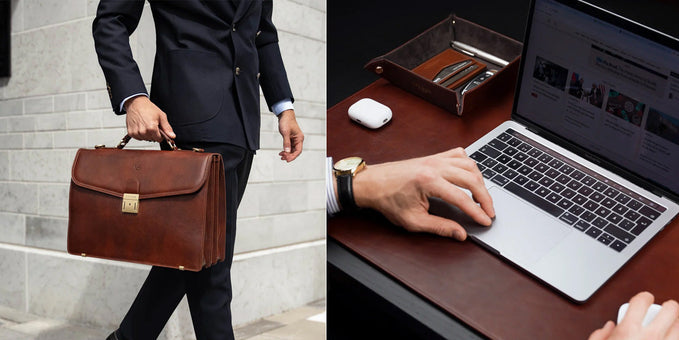How to fix faux leather peeling

Faux leather is a popular material for creating affordable leather-look products, but due to its multi-layer construction, and can peel and flake off over time.
Peeling happens when the polyurethane coating pulls away from the base fabric.
While it is hard to repair vegan leather (many manufacturers warn against it), you can restore its smoothness with our faux leather repair hacks below.
5 Ways To Fix Peeling Faux Leather
Permanent Marker Pen

You can use a permanent marker to repair a beloved faux leather jacket or handbag.
- First, you need to remove the flaky area with fine sandpaper.
- We recommend using a circular motion and only applying light pressure to the top layer to avoid damaging the base fabric.
- Wipe with a clean cloth and use a matching marker pen to color over the damaged area.
- You may need to go over the spot three or full times for maximum coverage and top up the color after wearing.
Discover and buy your perfect shade from our well-tested range of brand permanent marker pens here here.
Shoe Polish
Shoe polish is ideal for repairing faux leather, but it's not suitable for all vegan leather products.
If you intend to try this method, remove the damaged area using fine sandpaper and apply matching shoe polish using a clean rag.
You can build coverage with multiple layers but remember; shoe polish may mark your clothes if you use it to repair a faux leather jacket or handbag.
Purchase shoe polish for your faux leather repair here.
Leather or Acrylic Paint
Another way to repair faux leather furniture, bags, and clothing is with leather or acrylic pain.
- As with the previous methods, you should remove the peeling areas with fine sandpaper to create a clean, smooth surface.
- Next, apply matching paint with a fine paintbrush using long, horizontal strokes.
- You should allow each coat of paint dry for at least 30 minutes before attempting to apply any further layers, and then continue building color as necessary.
- Don’t be surprised if you need three or four coats; leather paint typically fades as it dries.
- Applying a high-gloss or matte topcoat will help seal the painted area, and you may need to paint an entire section of your fake leather handbag, jacket, or sofa for a uniform finish.
Purchase acrylic leather paint in the color of your choice here.
Unfortunately, repairing faux leather goods with leather paint is a short-term fix, and you should expect them to peel again.
Leather Filler

If you want to repair a faux leather sofa, a leather filler may provide the best results, but it requires a little more work than alternative methods.
You’ll need time, proper equipment, leather filler putty, and leather paint to resurface the damaged area, but if you have spent several hundred dollars on your sofa, it might be worth the effort.
Here’s how to do it:
- Remove the peeling area with fine sandpaper, a sharp blade, or even your fingers, but avoid removing more than is absolutely necessary.
- Wipe the surface clean and apply a thin layer of leather filler using a putty knife. Smooth it out to ensure an even thickness but try not to get filler on any untreated area.
- When the leather filler bonds with the synthetic base, it will create a smooth vinyl-effect surface.
- Allow it to set for at least 30 minutes before attempting to remove any surplus with a piece of stiff card or plastic scraper tool.
- Apply a second layer and let it dry fully before smoothing the surface in preparation for the next step.
- Next, you should paint the surface using leather or acrylic paint that matches the rest of your faux leather sofa.
- Apply the paint in thin layers, gradually building color and coverage until you reach the desired finish and allow it to dry.
- A top-coat (matte or gloss) will prolong the lifespan of your repairs.
Browse and purchase leather filler in the color of your choice here.
Nail Polish

Nail polish is a quick, easy, and inexpensive fix for faux leather bags, jackets, and furniture.
You can apply it almost anywhere to disguise peeling damage and reapply it as often as necessary to restore synthetic leather goods.
You can use clear nail polish as a solo agent to fix minor surface damage or pair it with a permanent marker to instantly approve the appearance of wear and tear.
Here are our top tips for repairing fake leather with nail polish:
- Work in natural light or under a bright light for optimal color matching.
- Have all the necessary tools at your fingertips to avoid mistakes. Nail polish dries fast, so make sure you have fine sandpaper, nail polish remover, and plenty of cotton rags at your disposal.
- Preparation is key. Make sure your faux leather item is primed and ready for nail polish application before attempting any repairs. If not, you could do more damage than good.
- Be extra careful when using razors, plastic scrapers, and putty knives on faux leather surfaces. Unlike genuine leather, they crack and tear easily, so take it slowly, only apply minimal pressure, and if in doubt, stop before you go too far.
Browse and purchase nail polish in the color of your choice here.
Related leather guides:
- Repair cat scratches on leather
- Remove water stains from leather
- Clean leather wallet & remove stains/smells
- Remove ink from leather
- Get smell out of leather
- Remove stains from leather shoes
- Clean suede leather bag
- How to reform a leather bag
- How to maintain leather bags
- Repair cracked leather
- Wet leather
- How to clean leather bag
- How to restore faded leather bag
What is the Difference Between Bonded Leather & Faux Leather?
Bonded leather (or reconstituted leather as it is commonly known) is a composite material made of scrap leather and polyurethane.
US trademarked names include EnviroBlend® and DuraBlend®, but there are others worldwide. Bonded leather typically consists of 10-20% genuine leather and 80-90% synthetic materials and is used to make low-cost leather products.
Faux leather (derived from the French word for fake) is a 100% synthetic fabric made from manufactured materials.
Manufacturers typically use rayon and polyester to create this versatile material and apply a polyurethane skin to give it the look of genuine leather.
Unlike bonded leather, faux leather doesn’t include any real leather or animal byproducts, making it a popular choice for vegan designs.
If we were to compare faux leather to other inexpensive materials, it would be most similar to cheap particle board, a material often confused with quality PVC, but its characteristics are unlike any other.
The beauty of synthetic leather is that it is versatile, inexpensive, and relatively easy to produce, but it has problems.
The polyurethane coating applied to faux leather develops cracks over time, and when this happens, repairs are costly and complex.
Sadly, this surface damage, known as ‘hydrolysis-related failure’, is typically excluded from any warranty, so there’s no way of claiming your money back.
In the faux leather industry, manufacturers use the ISO 1419 Tropical Test Method C to assess the ‘hydrolysis resistance’ of their materials, but with The Association for Contract Textiles recommended minimum rating of 5 weeks, it is unrealistic for anyone to think that their imitation leather products will last for years.
Browse our related leather articles:
- Buying a leather bag
- How to burnish leather
- Is leather waterproof?
- How to waterproof your leather bag
- How long does a leather bag last?
- Leather
- Faux leather
- What is artificial leather?
- Where does leather come from
- Leather grades
- How is leather made
Why is there Confusion Between Faux Leather & Genuine Leather?
Unless you work in the manufacturing industry or sell leather goods for a living, it is unlikely that you will know the difference between faux leather and genuine leather at a glance.
And while retailers are responsible for describing their products accurately, confusion is widespread.
In the United States, the term ‘leather’ was only regulated in 2017 (source), so any items manufactured before that date can proudly carry the ‘leather’ title without being leather at all.
In China and India, where the majority of our imitation leather comes from, ignorance prevails, and many fake materials carry the word ‘leather’ - only adding to the confusion.
To provide some clarity, we need to look at costs. Let’s use a genuine top-grain leather sofa as an example:
- At wholesale top-grain leather costs approximately $105 per yard.
- To upholster a recliner chair, you would need between five and seven yards, equating to $525 and $735 in leather costs.
- To upholster a 3-seater couch, you’ll need around 15-20 yards of leather at $1,575 to $2,100.
- Upsize to a 6-seater sectional, and you need to estimate $3,150 for 30 yards of leather.
The above figures relate to leather costs only. Once you add the costs for the additional materials required, such as wooden framework, foam padding, and metal fixtures, it is easy to understand why genuine leather articles cost as much as they do.
Add labor into the mix, and there’s no way you will get a real leather couch for $2,000. The figures just don’t add up.
Related articles:
- How to stretch leather
- How to shrink leather
- How to soften leather
- How to wash leather
- Bonded Leather Peeling
- Bleach On Leather
- How To Fix Scuffed Leather
- How To Rehydrate Leather
- How To Stiffen Leather
- How To Restore Leather
- How To Dye Leather
- How To Get Wrinkles Out Of Leather
- How To Clean Leather
- How To Clean Leather Purse
- Stitching Leather
Conclusion
We hope you enjoyed our article on how to fix faux leather peeling.
If you have any questions or comments, contact us at info@vonbaer.com, or leave them in the comments.
Want to read more? Check out our Leather pages here.
Related articles:
- How To Clean Mold off Leather
- How To Clean Faux Leather
- How To Repair Leather
- Leather Burning
- Best Leather Cleaners & Conditioners
- How To Get Sharpie off Leather
- How To Clean Suede
- DIY Leather Conditioner
- Wet Molding Leather
- Best Leather Oil
- How To Clean White Leather
- How To Get Oil Out of Leather
- Clean Leather Car Seats

Author: Albert Varkki
Albert Varkki is the co-founder of Von Baer. He understands leather products as a consumer, supplier, and a manufacturer, helping you with the inside knowledge you need, to choose the perfect leather product for you.
We strive for the highest editorial standards, and to only publish accurate information on our website.
Leave a Comment
Your email address will not be published.






